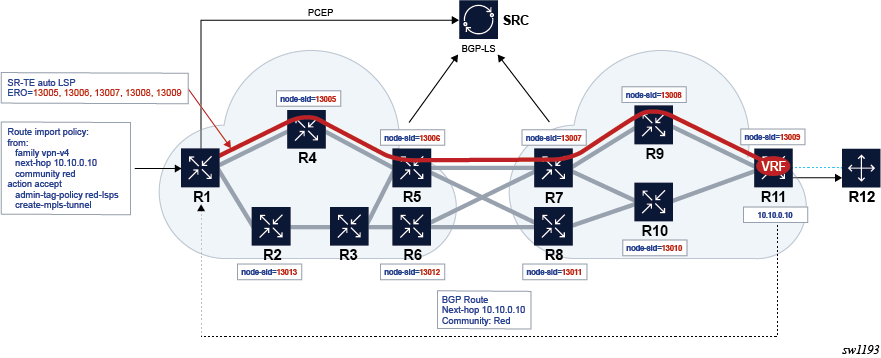The SR-TE on-demand LSP simplifies provisioning for networks that may or may not be managed by a network service manager, such as the Nokia NSP. Instead of using a full mesh, LSPs can be automatically created on-demand when a suitable existing tunnel does not exist for a particular BGP prefix next-hop. The prefix could be for base-routing and VPRN or EVPN routes or BGP-LU or BGP shortcuts. Both intradomain and inter-domain use cases are supported.
- VPRN auto-bind-tunnel
- EVPN VPWS auto-bind-tunnel
- EVPN VPLS auto-bind-tunnel
- BGP-LU, both as an LER and LSR at an ABR or ASBR
- BGP shortcuts
The following figure illustrates an application of SR-TE on-demand LSPs.

This example combines route transport coloring and auto LSPs to simplify provisioning for intent-based networking for specific services. In this use case, intent means the ability to meet traffic engineering requirements for a service. This could be, for example, a delay or loss, or the ability to steer the service traffic to avoid LSPs that transit specific geographies or prefer those that take another route.
In this example, a BGP route is advertised for a VRF in a PE for a VPRN service. An extended color community is assigned to the route. This color implies an intent associated with the transport requirements.
- The route is matched in a route-import policy.
- An admin-tag-policy called red-lsps is applied.
- A trigger action occurs to create an MPLS tunnel to the BGP next-hop for the route.
This causes the head-end router to create an SR-TE auto LSP that matches the red LSPs admin-tag policy and steers the traffic associated with "red" routes to the far-end PE, into the red LSP. This SR-TE auto LSP is created based on the configuration in the matching LSP template.
SR OS also offers the ability to use either local CSPF, hop-to-label-translation or a PCE to provide a path for the red LSP. This is determined by a configuration in the matching LSP template.
-
Define a policy statement to import the route, as shown in the following example:
configure>router>policy-options>policy-statement entry from family <family> next-hop <ip-address> community <comm-name> action accept admin-tag-policy <admin-tag-policy-name> create-mpls-tunnelThe create-mpls-tunnel action is supported for the following address families:- vpn-ipv4
- vpn-ipv6
- evpn
- label-ipv4
- label-ipv6
- ipv4
- ipv6
This assigns an admin-tag-policy to the routes that are imported with a specific next hop and match a specified extended community. In most applications, the extended community is the transport color extended community. The create-mpls-tunnel action causes BGP to send the next hop and the include and exclude constraints in the admin-tag-policy (if one was assigned to a route by the policy statement) to the MPLS application.
When such a policy statement is applied in the context of a specific VRF, the create-mpls-tunnel trigger is only actioned by BGP on a per-next-hop basis.
-
Configure the auto LSP under MPLS with the template type on-demand-p2p-srte.
This type of LSP template supports PCE computation and control and fallback path computation method if the PCE is unreachable. The auto-LSP is configured using the following command:
configure>router>mpls auto-lsp <on-demand-p2p-srte-template-name>The LSP template may contain an LSP admin-tag-policy. MPLS takes the next hop, and admin-tag includes/excludes constraints from BGP and matches them against the auto-LSP statement with a template with an admin-tag that conforms to the admin-tag-policy constraints.
If BGP does not pass any admin-tag-policy constraints, MPLS only matches against LSP templates that do not have the admin-tag option configured.
If the next-hop and admin-tag-policy match more than one auto-lsp statement, an LSP is created for each matching entry. This results in an ECMP set to the next hop.
Note: Each LSP may have a different admin-tag value, but it is an ECMP next-hop tunnel from the perspective of the colored route that triggers the tunnel creation.A new SR-TE LSP is consequently created to the next hop passed by BGP according to the parameters contained in the LSP template.
The router tracks the binding between BGP triggers and on-demand LSPs that are successfully created and deleted toward a specified BGP next-hop matching an admin-tag-policy.
-
The classic CLI no auto-lsp (or MD-CLI delete auto-lsp) command is executed. This triggers MPLS to remove auto LSPs created by this command.
-
The no create-mpls-tunnel is configured in a policy statement that previously had create-mpls-tunnel configured. This triggers a re-evaluation of the policy statement and potentially trigger BGP to inform MPLS that it no longer needs a tunnel.
-
BGP tracks the binding of a route to an admin-tag-policy. If an admin-tag-policy name in a policy statement action changes, the policy is re-evaluated, which could change the binding. This may result in a request to create a new tunnel or delete an existing tunnel. However, if the contents of an admin-tag-policy that is referenced in a policy statement action change, BGP does not react (for example, request the creation or deletion of a tunnel), although a subsequent route resolution may change.
-
MPLS reacts to admin-tag changes in the LSP template. When this occurs, it re-evaluates the admin-tag-policy associated with a request from BGP and deletes or creates tunnels accordingly.
-
If a new LSP is created that is not an on-demand LSP and is preferred to an existing on-demand LSP, BGP can resolve the next hop over the new LSP and traffic moves to it. In this case, the system does not remove the older less-preferred auto-LSP, which was created through an on-demand LSP trigger, until the next hops are removed.
-
If the LSP template is shutdown all associated LSPs are administratively disabled. To delete the LSP template you must first shut it down, using a no auto-lsp command in classic CLI or delete auto-lsp command in MD-CLI. This removes all the auto LSPs using the template.